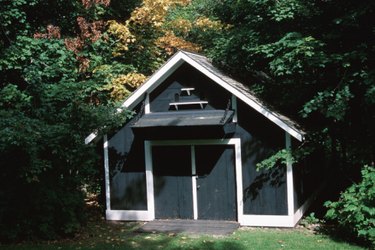
When you're building a shed, concrete is usually the most typical choice for flooring material. Since concrete is used to form the shed's foundation, it is an easy, inexpensive and durable option. However, if you aren't a fan of concrete's drab, gray look and prefer a more decorative appearance for a shed where you will spend time working, there are several alternatives for your shed floor that may be a better fit for your needs.
Treated Lumber
Video of the Day
Treated lumber is an ideal alternative to concrete for your shed's floor. This type of wood is treated with chemicals to resist insect infestation and rot, two major factors that limit wood's durability. As a result, a treated lumber shed floor has greater moisture resistance, so it is not damaged by water seeping up from the soil, rainfall or water that leaks from garden equipment or other tools. You can also opt for treated timber floorboards that have tongues and grooves, which allow for easy installation and an extremely stable floor for your shed.
Video of the Day
Oriented Strand Board
Another alternative to a basic concrete floor in your shed is an oriented strand board (OSB) floor. OSB is made from solid wood strands that are intertwined and overlapped at a 90-degree angle. All of the strands are covered with resin glue that holds them together and are placed in a hot press so the glue penetrates into the strands as deeply as possible. As result, the finished product is extremely rigid and strong. The OSB used for shed flooring is usually tongue and groove, with square ends. The boards also have a weak and strong direction, so their placement is critical when installing the floor. The strong direction for OSB is the long direction, so make sure it runs at 90-degree angles to the floor joists.
Treated Plywood
Treated plywood provides a durable, inexpensive alternative to concrete flooring for your shed. As with treated lumber, this type of plywood is treated to resist insect infestation and wood rot, making it more moisture-resistant and durable. Treated plywood floors are usually square-ended, so they require additional support at the joints where two boards meet. As with OSB, treated plywood also has a weak and strong direction. To ensure that your shed floor is as strong as possible, install the plywood boards so the face grain runs at 90-degree angles to the floor joists.
Brick Pavers
For a concrete floor alternative that provides a decorative element to your shed, opt for a brick paver floor. You can build your shed around an unused patio area or install new pavers. A new installation requires digging out the area for the floor and compacting the soil as firmly as possible. Place a layer of gravel or sand over the area. Use the brick pavers to create a pattern for the floor, fitting the stones together as tightly as possible. Sprinkle sand over the pavers and sweep it into the joints to create a stable floor for your shed.